Flowers for the kitchen: purpose, varieties, selection and placement

Plants in the kitchen help create a cozy atmosphere, give the room freshness, and help relieve stress after a busy day. Some flowers not only absorb carbon dioxide, but also various harmful compounds that enter the room through the window.
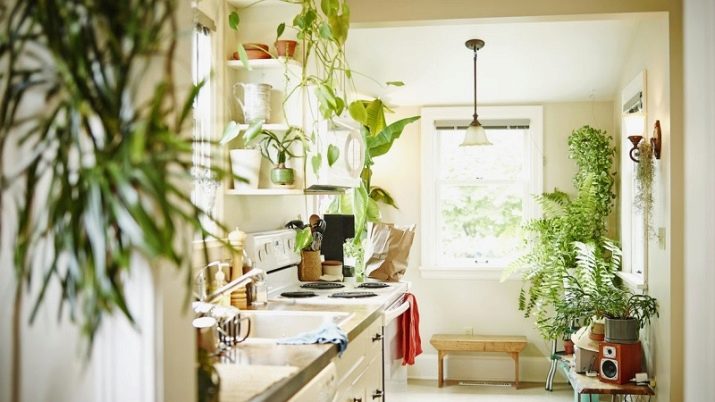


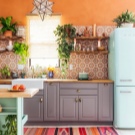


What are they for?
Modern stone jungle, stuffy subway, cold offices take a lot of energy from people. To recuperate, live plants come to the rescue. Not every person has the opportunity to be alone with nature in a park or forest every day, but there is an opportunity to plant greenery in their own home to their liking.
Potted flowers bring a lot of aesthetic pleasure, but they must be resistant to changes in humidity and temperature., because in the kitchen there are quite extreme conditions during cooking. Indoor plants are not only aesthetic function, but also purify the air in the room.
Some potted flowers can inhibit the multiplication of microbes, which is especially true in the cold season, when epidemics of respiratory viral diseases are raging.


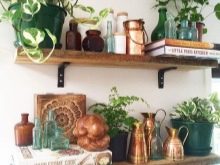
You can start landscaping with one flower, develop the most convenient care algorithm and practice for several months. With a successful development of events, it will be possible to create a whole Garden of Eden in a single kitchen. Climbing plants look very beautiful in the kitchen.
Artificial plants in pots do not carry any practical benefits, although they are the most unpretentious: it is enough to rinse them from dust a couple of times a year. This option is suitable for allergy sufferers and lovers of frequent interior changes.
Plastic or fabric flowers do not grow or change their shape, they can be used as seasonal decor (New Year's, Easter).



Which ones can you keep?
A versatile and useful solution would be to breed edible greens in the kitchen in beautiful miniature boxes: onions, dill, parsley, arugula, and basil. You can even plant beans that will curl into a beautiful vine. Such plants will not only decorate the interior, but will delight the whole family all year round with their fresh taste and pleasant aroma. Some plants are recommended for cultivation in the kitchen, but they can be very moody in their care.
- For example, ficus benjamin needs frequent spraying and regular watering, it is worth watering once later than the due date, as he immediately drops the leaves.
- If the kitchen is sunny, it works best. succulents: all varieties of aloe and kalanchoe, as well as cacti. They need a minimum of moisture, they can rarely be watered (once every 2 weeks). Children and pets are almost not interested in such plants. They are safe for allergy sufferers and look beautiful all year round, unpretentious to any kind of soil.
- Hibiscus chinese needs good lighting, moderate watering, tolerates humid air well, has a beneficial effect on other plants.
- Begonia Is a beautiful plant that blooms almost all year round. Do not forget that begonia is poisonous, however, it disinfects the air in the room no worse than a quartz lamp, loves partial shade, but needs diffused sunlight for at least 2 hours a day.
- Crassula (the so-called money tree) needs good drainage, as it has a rather weak root system. It is unpretentious to the composition of the soil and can withstand irregular watering. As it gets dirty, it is necessary to wash the dust off the leaves with a slightly warm shower of medium pressure water.
- If there is little sunlight in the kitchen, you should pay attention to the following plants: dwarf ficus, dieffenbachia, anthurium, dracaena, fern, hedera (ivy)... However, be careful: the juice of their leaves contains poison.
- Sansevieria (mother-in-law's language) grows equally well with an abundance of sunlight and partial shade, loves humidity, needs annual replanting for the first 3 years.
- Unpretentious to any conditions are golden mustache, cyperus, tradescantia, chlorophytum... Such plants resemble ordinary grass in appearance, which attracts cats.
- A coffee tree (not to be confused with coffee bean topiary, despite the similar name) grows well, needs a drainage layer, the first 3 years requires an annual transplant. In the third year after planting, it begins to bear fruit, but after 8 years the beauty of such a plant withers, the leaves become sparse, the number of fruits is significantly reduced.
- Decorative pepper bears fruit all year round (some varieties with edible fruit), loves temperatures around 25 ° and diffused sunlight.
- Geranium fragrant brings many benefits: it disinfects the air, but it is the strongest allergen.
- Bamboo grows very quickly, it is only suitable as a hedge between the dining and work area in spacious kitchens.

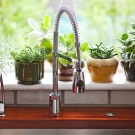
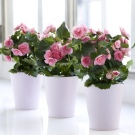



How to choose?
It is not difficult to choose plants for the kitchen; it is enough to study the conditions of detention and dwell on the most unpretentious options. There are a few factors to consider before purchasing.
- The amount of sunlight entering the room through the window. Some plants like the sun and thrive better in these conditions, while others, on the contrary, prefer shade. If necessary, you can correct the lack or excess of sunlight through the installation of special phytolamps.
- The presence of drafts. Some flowers begin to ache and may even die from a draft.
- The minimum air temperature in the kitchen (especially if it is a summer kitchen in the country), which should not fall below 15 °, otherwise the plants will die.
- Features of the plant's growth and life cycle: some flowers bloom only once a year and at the same time need rest for a long period of time, while others are constantly covered with blossoming and new buds.
- Features of care: the need for frequent feeding, flushing, water baths, transplants.
- The presence of small children in the home: some plants are poisonous.
- Accommodation of pets that like to gnaw leaves and young shoots. You need to think about where to place flower pots so that they become inaccessible to pets.
- The presence of allergy sufferers in the house. In this case, it is necessary to choose plants without a pungent odor.



Flowers in pots, the shoots of which were taken from a kitchen with a similar humidity and temperature conditions, take root best of all.
Indoor plants for the kitchen should be as easy to clean as possible, so as not to take extra time from their owners.


Where to place?
You need to choose the right location for the flowers in the kitchen and always keep the plant pots in their places. Some types of flowering plants can get sick even from turning the pot. Greening the kitchen is best done in spring, it is at this time that most potted plants need replanting and take root most easily. It can be rearranged only in case of emergency: illness or deterioration in the appearance of the flower. A universal solution is to place flowers on a free wall in a planter at a level convenient for watering, away from the stove and sink.
Curly specimens are best placed at a distance of 50-80 cm from the ceilingas heat builds up at the top and can harm the plants. If the kitchen is on the sunny side, it is not recommended to put flowers on the windowsill, even the most thermophilic flowers in pots can die from exposure to direct sunlight.
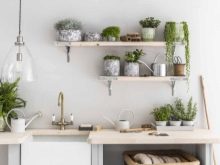


The dimensions of the room should also be taken into account: large plants, for example, an ornamental palm tree or rapidly growing ones, such as a birch, will be out of place in a small kitchen, and small ones (violets) will get lost in a spacious room or on a wide windowsill. For a small kitchen, decorative peppers, a coffee tree are suitable, and for a large kitchen, orange and lemon trees. You can plant a small lemon or orange tree in a beautiful tub, but floor-standing options are not suitable for a standard kitchen. They will only look good in the dining area of the spacious kitchen area.
In the smallest kitchen, you can organize a beautiful mini-garden with skillful selection and arrangement of plants. You can use special racks, but they will need to be properly secured.



Vertical gardening is also very popular today.
- Fitostena - vertical structure from floor to ceiling, filled with plants. It can be attached to the wall or act as a partition in the room. Tradescantia and peperomia are best suited for this.
- Phyto picture. It can look like a phytowall fragment, framed on a regular wall. Its size varies at the discretion of the owners. Plants can be used in the same way as in the preparation of phytowalls, and the composition is made from stabilized moss of different shades.
This method of planting plants allows you to significantly save space by placing flowers on racks, it is used when zoning a room. The vertical arrangement of plants requires the installation of a solid frame, since one shelf of the rack, about 1 m wide, can accommodate up to 10 plants. The main load on the structure is provided by the earth and drainage.


Beautiful examples
Flowers in pots are capable not only of creating coziness, purifying the air in a room, but can be a separate design element in a kitchen decorated in an ecological or ethnic style. In order for harmony to reign between the plants, you need to select species that get along well and not overload the room with greenery. It can be very problematic to independently determine the location and selection of flowers in pots, so you can use photos of beautiful examples:
- greens for cooking various dishes.

- succulents and cacti.

- pepper.
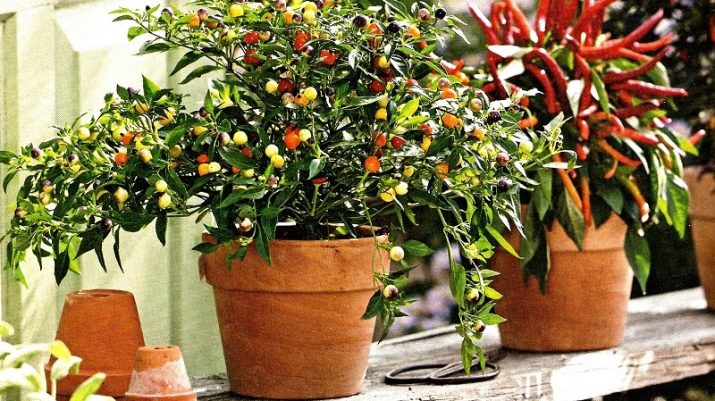
- lemon tree.

- ivy.

- palm.

- phyto picture.

- phytowall.

- peperomia.

For information on which plants are suitable for growing in the kitchen, see the next video.








